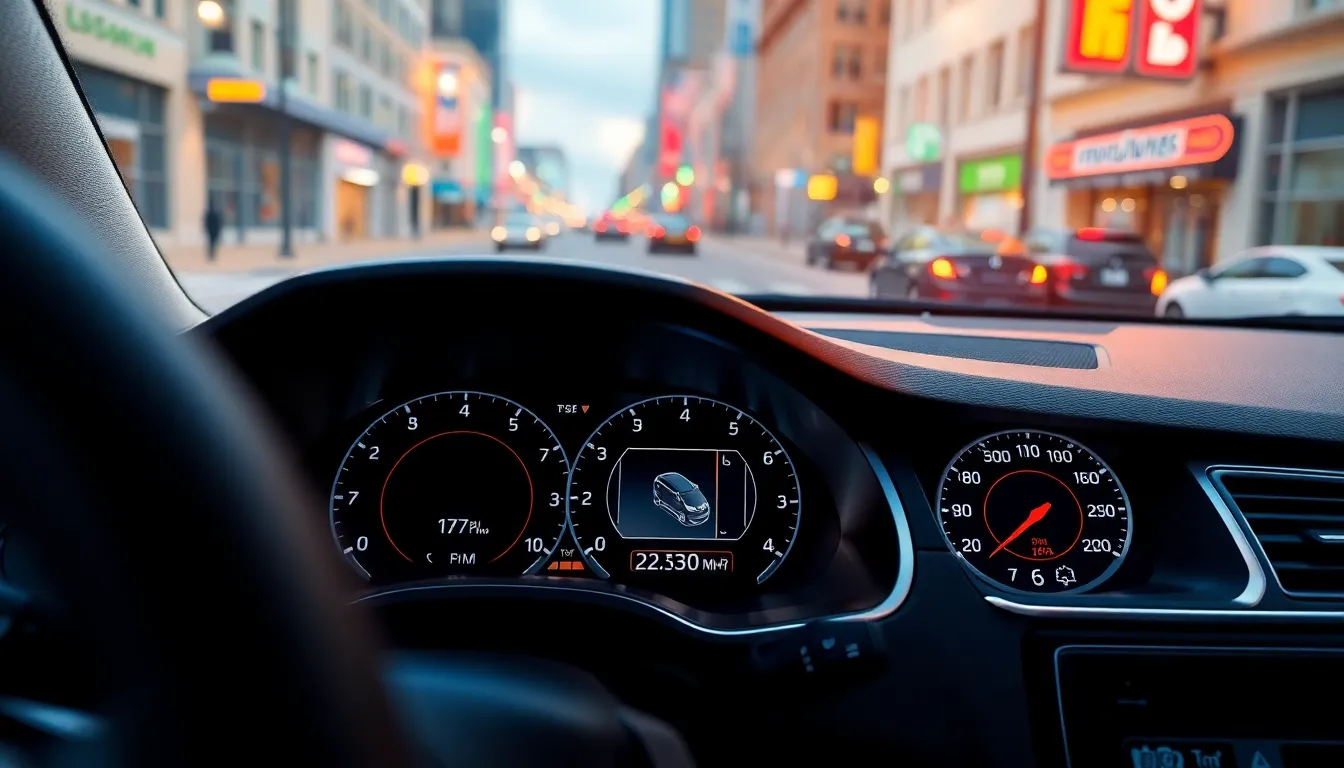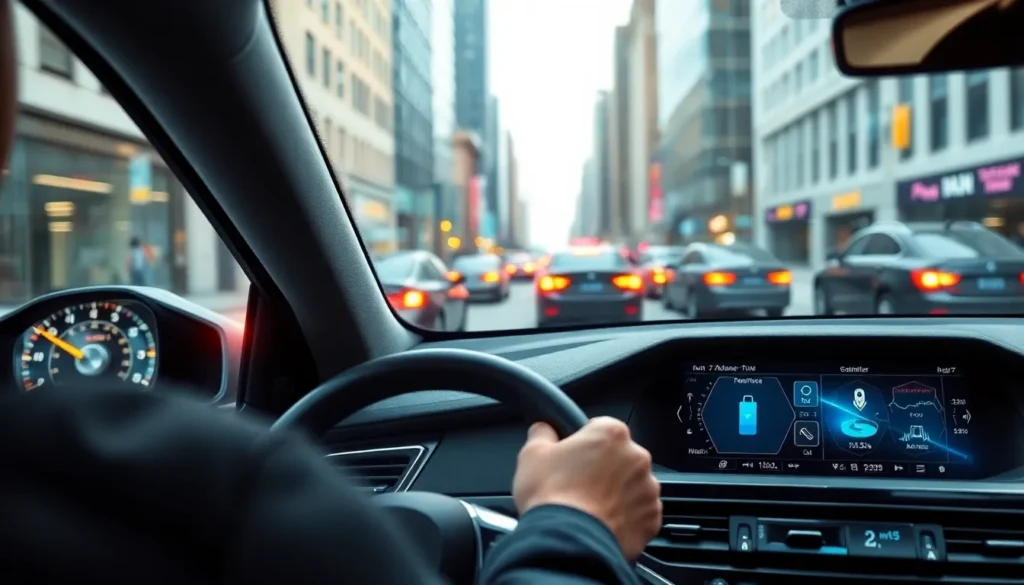Table of Contents
ToggleImagine a world where your car knows you better than your best friend. Welcome to the Internet of Things (IoT) in the automotive industry, where vehicles are no longer just metal boxes on wheels. They’re becoming smart companions that can chat, navigate, and even remind you to grab milk on your way home.
With IoT technology, cars are transforming into data-driven machines, seamlessly connecting to the internet and each other. This shift not only enhances safety and efficiency but also offers a glimpse into a future where traffic jams and missed appointments could be relics of the past. Buckle up as we explore how this high-tech revolution is reshaping the driving experience and making our roads smarter, one connected car at a time.
Overview of Internet of Things Automotive
The Internet of Things (IoT) in the automotive sector integrates advanced connectivity into vehicles. Smart sensors facilitate real-time data exchange, enhancing vehicle performance and user experience. Increased vehicle automation leads to improved safety, as systems can predict and react to potential hazards more effectively.
Connected cars now feature adaptive navigation tools that adjust routes based on traffic conditions. Analytics drive insights into driver behavior, allowing manufacturers to personalize services and future enhancements. The incorporation of IoT technology fosters seamless interaction between vehicles and infrastructure, creating a more intelligent road ecosystem.
Vehicle-to-everything (V2X) communication plays a crucial role in reducing traffic congestion, optimizing routes, and minimizing accidents. Platforms that leverage real-time data enable automakers to deliver predictive maintenance alerts, reducing downtime and repair costs. As connectivity evolves, so does the potential for autonomous vehicles, which rely heavily on IoT for safe navigation.
Collaboration among industries can advance IoT functionalities, integrating automotive systems with applications like smart city infrastructure. Enhanced connectivity not only streamlines manufacturing processes but also improves user engagement through in-car services and entertainment options. Together, these developments signify a significant shift towards more efficient and technologically advanced transportation.
Key Technologies Driving IoT in Automotive

Innovations in the automotive sector hinge on several key technologies that enhance connectivity and data processing capabilities.
Connected Sensors
Connected sensors serve as the backbone of IoT in vehicles. They monitor various aspects such as tire pressure, fuel levels, and engine performance. These sensors collect real-time data, which they relay to central systems that analyze the information promptly. Vehicles equipped with advanced sensors respond swiftly to changes in driving conditions. Anomaly detection features reduce response time to potential hazards, boosting overall safety. Utilization of these sensors also aids manufacturers in designing more efficient vehicles that cater to user needs and preferences.
Data Analytics and Cloud Computing
Data analytics plays a critical role in harnessing the information collected from connected vehicles. Cloud computing platforms store vast amounts of data, enabling automakers to process and analyze trends. Predictive analytics identifies patterns in driver behavior, leading to tailored services and proactive maintenance alerts. Leveraging cloud technology ensures that manufacturers can update vehicle software, enhance performance, and improve user experiences seamlessly. Insights gleaned from data analytics drive innovations that further advance automotive safety and efficiency, paving the way for smarter transportation solutions.
Benefits of IoT in the Automotive Industry
The integration of IoT in the automotive sector brings numerous advantages, enhancing both vehicle performance and user experiences.
Enhanced Safety Features
Advanced safety features emerge with IoT communications that utilize real-time data. Vehicles equipped with smart sensors can detect potential hazards earlier than traditional systems, enabling swift action to prevent accidents. This predictive capability relies on data analytics that monitor surroundings and assess driving conditions, allowing systems to adapt accordingly. Additionally, V2X communication links vehicles with their environment, sharing critical information on traffic patterns and road conditions. As a result, driving becomes safer with reduced accident rates, enhancing overall road safety for all users.
Improved Fuel Efficiency
Fuel efficiency increases significantly through IoT technologies that optimize vehicle performance. Analytics monitor engine functions and driving habits, providing feedback to improve fuel consumption. Vehicles can adjust driving modes based on real-time data, promoting eco-friendly driving techniques. Smart navigation systems also advise drivers on optimal routes, reducing idling time and unnecessary detours. By leveraging these insights, automakers contribute to lower emissions while consumers benefit from reduced fuel costs. This efficiency not only saves money but also supports environmental sustainability initiatives.
Challenges and Concerns
The integration of IoT in the automotive sector faces several challenges and concerns that require attention.
Security Risks
Security risks pose a significant threat to connected vehicles. Cyberattacks targeting automotive systems can compromise vehicle functionality, leaving drivers vulnerable. Hackers may exploit vulnerabilities in software or networks, gaining unauthorized access to critical systems. Manufacturers must implement robust security measures to protect against these threats. Encryption protocols and regular software updates enhance vehicle security significantly. Moreover, collaboration with cybersecurity experts helps companies anticipate potential vulnerabilities before they are exploited.
Data Privacy Issues
Data privacy issues arise as vehicles become more connected. Vehicles collect vast amounts of personal information, raising concerns about how this data is stored and used. Unauthorized access to sensitive data such as location and driving habits can lead to serious breaches of privacy. Regulations like the General Data Protection Regulation (GDPR) guide manufacturers to safeguard user data. Transparency in data usage policies can foster consumer trust. Implementing strict data management practices ensures that personal information remains confidential and secure, thus addressing growing concerns in the automotive landscape.
Future Trends in IoT Automotive
Emerging trends in the IoT automotive landscape emphasize increased vehicle connectivity. Companies invest heavily in connected sensors and smart technology, making user experiences more seamless. Enhanced artificial intelligence models play a vital role in processing real-time data, allowing vehicles to adapt quickly to driver needs.
Advanced driver-assistance systems (ADAS) gain traction as safety measures become a priority. ADAS incorporates features like automated emergency braking and lane-keeping assistance, significantly reducing accident rates. Integrating V2X communication enhances vehicle intelligence, fostering improved interaction between vehicles and their environments.
Data analytics evolve further, allowing automakers to predict maintenance needs more accurately. Predictive maintenance solutions reduce downtime, increasing overall vehicle reliability. Cloud computing capabilities facilitate software updates, ensuring vehicles maintain peak performance with minimal interruptions.
Customer preferences also shape future trends. Personalized experiences catered to individual driving patterns become the norm, enhancing user satisfaction. Automakers gather insights from connected vehicles to tailor services, from navigation preferences to maintenance schedules.
Sustainability efforts gain importance as regulations around emissions become stricter. Collaborations between automotive manufacturers and smart city developments enhance eco-friendly initiatives. These partnerships allow vehicles to communicate with traffic systems, promoting efficient navigation that reduces fuel consumption and emissions.
Challenges persist in security and data privacy as connectivity increases. Manufacturers address vulnerability through strong encryption methods and secure data management practices. Transparency in data usage helps build consumer trust, ensuring users feel confident in their vehicle’s technology.
Overall, future trends in IoT automotive indicate rapid advancements toward smarter, safer, and more environmentally friendly vehicles. The industry witnesses a shift in focus toward user-centric innovations that prioritize safety, efficiency, and sustainability.
The integration of IoT in the automotive industry marks a pivotal shift towards smarter and safer driving experiences. As vehicles evolve into connected companions, they offer enhanced safety features and improved fuel efficiency while promoting environmentally friendly practices.
However, addressing security and data privacy challenges remains crucial for manufacturers. With robust measures in place, the potential for autonomous driving and personalized user experiences can be fully realized.
The future of automotive IoT is bright, promising innovations that prioritize user safety, efficiency, and sustainability. As the industry continues to embrace these technologies, drivers can expect a more intelligent and seamless journey ahead.





